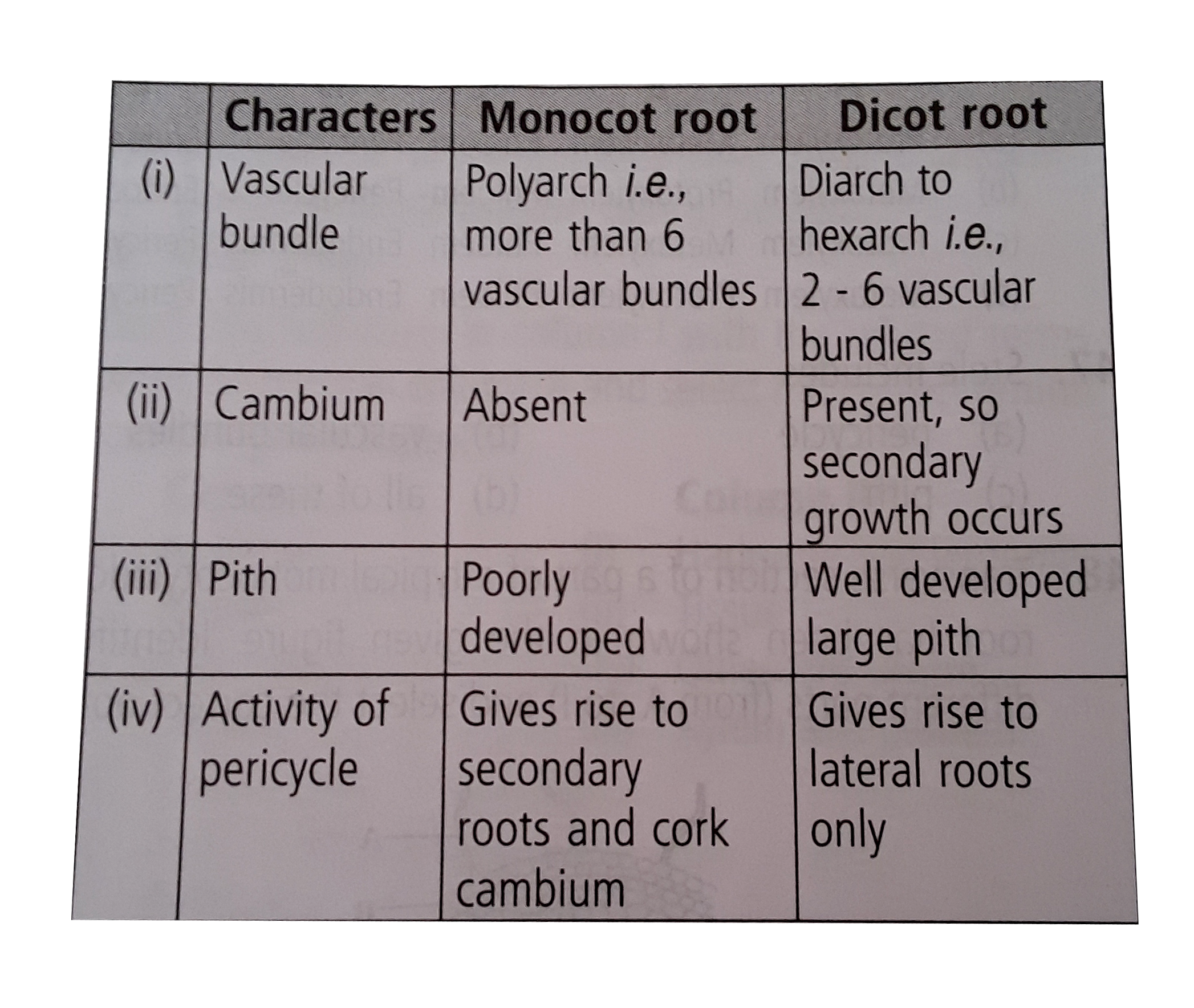In a monocot root
Formation of entire vascular cambium takes place by the cells of pericycle
Hypodermis is absent
Pith is small or inconspicuous
Endodermis is not distinct
Step-by-Step Text Solution:
1. Understanding Monocot Roots:
- Monocot roots have specific structural characteristics that differentiate them from dicot roots. It is essential to know these features to answer the question correctly.
2. Analyzing the Options:
- The question presents several statements about monocot roots. We need to evaluate each statement to determine which one is correct.
3. Option 1: Formation of Entire Vascular Cambium by Pericycle Cells:
- In monocots, the vascular cambium is typically absent. Therefore, this statement is incorrect.
4. Option 2: Hypodermis is Absent:
- In monocot roots, the hypodermis (a layer of cells beneath the epidermis) is indeed absent. This statement is correct.
5. Option 3: Cortex Made Up of Parenchymatous Cells:
- The cortex in monocot roots is primarily made up of parenchymatous cells. However, this statement is somewhat misleading because while it is true, it does not directly address the absence of hypodermis.
6. Option 4: Peat is Small and Inconspicuous:
- In monocots, the pith (often referred to as peat) is usually large and well-developed. Thus, this statement is incorrect.
7. Option 5: Endodermis is Not Distinct:
- The endodermis in monocot roots is distinct and plays a crucial role in regulating the movement of water and nutrients. Therefore, this statement is also incorrect.
8. Conclusion:
- After evaluating all the options, the only correct statement is that the hypodermis is absent in monocot roots. Thus, the correct answer is Option 2.
- Monocot roots have specific structural characteristics that differentiate them from dicot roots. It is essential to know these features to answer the question correctly.
- The question presents several statements about monocot roots. We need to evaluate each statement to determine which one is correct.
- In monocots, the vascular cambium is typically absent. Therefore, this statement is incorrect.
- In monocot roots, the hypodermis (a layer of cells beneath the epidermis) is indeed absent. This statement is correct.
- The cortex in monocot roots is primarily made up of parenchymatous cells. However, this statement is somewhat misleading because while it is true, it does not directly address the absence of hypodermis.
- In monocots, the pith (often referred to as peat) is usually large and well-developed. Thus, this statement is incorrect.
- The endodermis in monocot roots is distinct and plays a crucial role in regulating the movement of water and nutrients. Therefore, this statement is also incorrect.
- After evaluating all the options, the only correct statement is that the hypodermis is absent in monocot roots. Thus, the correct answer is Option 2.
Topper's Solved these Questions
Similar Questions
Knowledge Check

Following table summarises the differences between a monocot root and a dicot root. Identify the incorrect differences and select the correct optionA(i) and (iii)B(i) and (iv)C(iii) and (iv)D(ii) and (iii)In monocot root, we observe
Apolyarch, open, collateral vascular bouldesBsubersied exodermis, casparian strip, passage cell and c ambiumCxunserised exodermis, oplyarch exarch xylem, large pithDexodermis, endarch, tetarch, closed vascular bunldesas compared to a dicot root, a monocot root has
Amore abundant secondary xylemBmany xylem bunlesCInconspicuous annual ringsDRelatively thicker periderm
as compared to a dicot root, a monocot root has
View Solutionas compared to a dicot root, a monocot root has
View SolutionIn monocot roots, root cap is formed by the activity of ?
View SolutionIn monocot roots which types of vascular bundles are found
View SolutionA dicot root differs from a monocot root in which of the following -
View Solution
